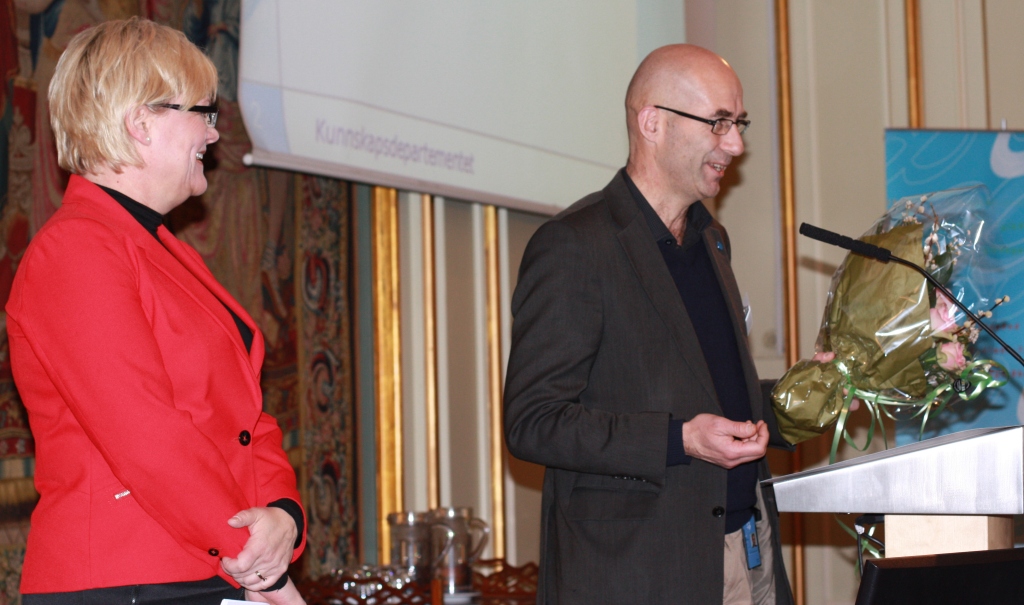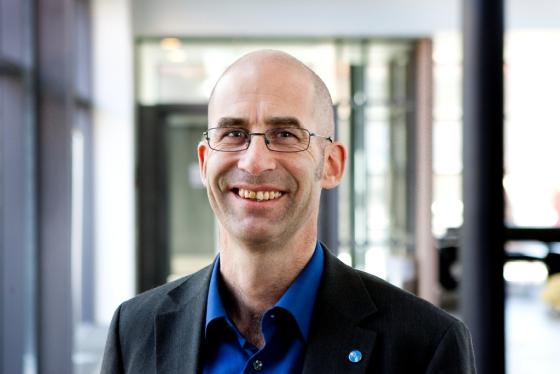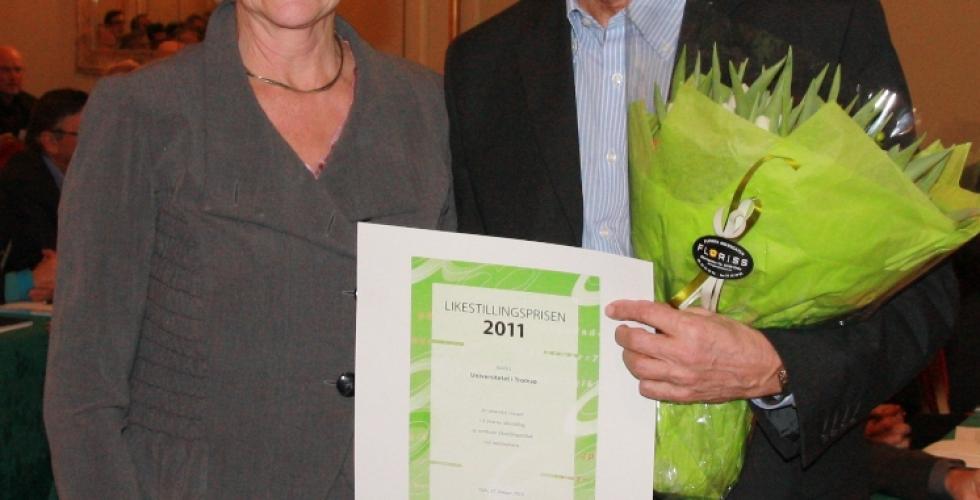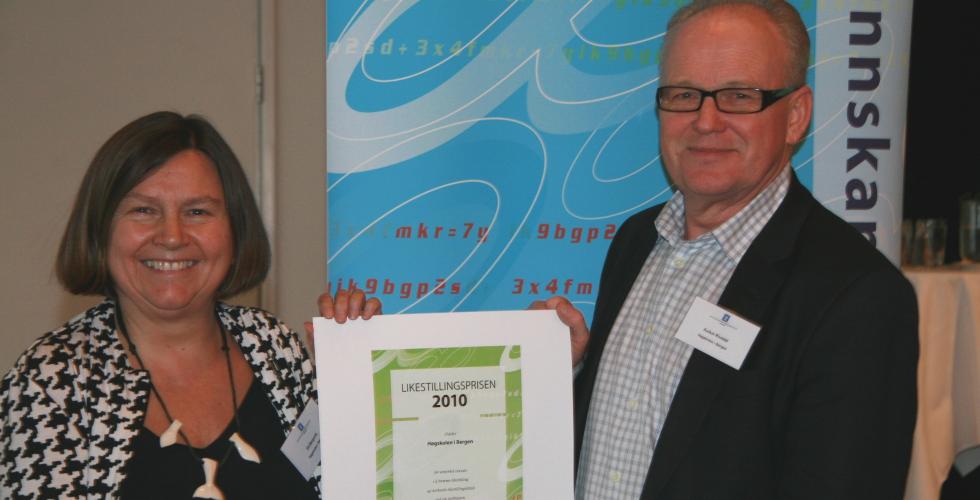Former male bastion wins Gender Equality Award
The Gender Equality Award was presented for the sixth consecutive year on 15 January, and the winner of the NOK 2 million prize is the Norwegian University of Life Sciences.
“This is a wonderful encouragement for us,” said Hans Fredrik Hoen, Rector of the Norwegian University of Life Sciences (UMB), when he accepted the award.
“The prize of NOK 2 million is fantastic. Now we will have the chance to implement several of the good measures in the action plan even more quickly. The measure to increase the percentage of female professors through a promotion project is at the top of our list,” said Hoen after the presentation.
In its recommendation of the winner, the Committee for Gender Equality in Research (the KIF Committee) states that UMB shows great willingness to tackle its gender equality challenges and that the measures are creative and harmonize well with those challenges. The committee continues:
UMB satisfies all of the criteria of the Gender Equality Award and clearly shows that a distinct change of attitude has occurred within the leadership and the organization in recent years.
“An important award”
“The Gender Equality Award obligates us to try even harder to achieve our goals. We are impatient, and the award will give a boost to our future efforts.”
UMB faces special challenges in its gender equality efforts due to its academic profile with many fields that have traditionally been male dominated. The work with the first action plan for gender equality first began in 2007, but enormous changes have taken place over the past four years.
Minister of Education and Research Kristin Halvorsen describes the winner:
“It is my pleasure to present the Gender Equality Award for 2012 to UMB. This year’s winner has worked systematically for gender equality, shown a noticeable change, set ambitious goals and based its gender equality efforts in the institutional leadership.”
Rector Hoen explains the efforts to bring about change at UMB.
“A few years ago, the gender equality efforts at UMB had a modest connection with the institution’s management level and financial activities, but in a relatively short time we have incorporated these efforts into the institution’s strategic focus and top-level administration. UMB has also prioritized funding for special gender equality measures,” he says.
Recipe for success
“What steps has UMB taken to improve the gender balance?”
“First of all, we have appointed a gender equality committee comprised of the vice-rector, two department chairs, a researcher in a temporary position and a student. The committee serves in an advisory capacity for UMB’s leadership. Secondly, the action plan has been followed up by management groups and the university board. The third element is that we have established a separate budget for gender equality funding. This has increased a little every year, and last year NOK 800,000 was allocated,” says Hoen.
“Today’s award is a multifaceted prize that aims to improve the quality of research. UMB has ambitious, but realistic goals for its gender equality work,” Halvorsen believes.
“Does UMB have any recommendations for other institutions in the research sector regarding how they can work with gender equality and gender balance?”
“When the top-level administration sends the signal that gender equality is important, it is easier for department chairs and others to seize the opportunity. This has happened at our institution, where both the vice-rector and the rector have taken the lead and the department chairs have followed up. This approach by the top-level administration is important so that the department chairs can do their part of the job,” explains Hoen.
Quality and attractiveness
“I want to take his opportunity to say that nothing happens by itself,” said Halvorsen, referring to the 100th anniversary of universal suffrage in Norway. She continues:
“We can look around us and see that we have made good progress, but we also recognize that we have not achieved full gender equality in academia. The fact that only 24 percent of all professors are women is not good enough.”
She believes that gender equality entails more than fairness. It also means ensuring a broad representation and drawing on the abilities and talents available. According to the minister, it is crucial that society makes use of both genders: Both genders must be recruited to the research sector, and both genders must be retained in the sector.
“The Gender Equality Award has to do with the quality and attractiveness of the institution. Gender balance has significance for research and the topics that are studied,” she believes.
The rector agrees:
“Our starting point for our gender equality efforts is simple. Gender equality and better gender balance makes the university better! It has to do with taking care of our talented employees and creating good workplaces. This will improve our results in the long run.”

Several projects
The percentage of female professors at UMB has been below the national average in the past three years, but the action plan for the recruitment of women for 2011-2013 contains new measures for reaching the target of 40 percent female associate professors and 30 percent female professors by 2020.
“The measures are now being targeted towards recruiting female researchers to fields with a low percentage of women,” says Hoen.
UMB offers start-up packages for women in permanent academic positions, grants to obtain qualifications at the professor level, search committees to attract more qualified women to permanent academic positions, funding for the departments to enact their own gender equality measures, and flexible schemes for families with small children. According to the rector, the university also prioritizes long-term staff planning and needs analysis prior to advertising job vacancies as well as annual performance reviews for employees in research and teaching positions. In addition, the booklet Talent at stake. Changing the culture of research – gender-sensitive leadership is incorporated into the institution’s leadership training.
“We have written a leadership handbook that gives advice about which measures fit with the individual department, and we have developed a project called ‘More time for research during normal working hours’, which is based on an employee survey showing that female researchers shoulder the greatest caregiving burden and experience the most tension between work and leisure,” explains Hoen.
The next project will focus on promotions.
“The percentage of women at the professor level has not shown the same increase as at the associate professor level. For this reason the gender equality committee wants to put more emphasis on this in 2013 with a promotion project that involves enhancing the leadership’s awareness of the talent found at the institution and identifying researchers who may be eligible for promotion to professor,” says Hoen.
Translated by Connie Stultz.
The Gender Equality Award for 2012, presented by the Ministry of Education and Research, was first announced on 14 June and the call for applications was issued on 23 August. The application deadline was 1 November 2012. Written information about the award was sent to all higher education and research institutions.
The award was also presented in 2007, 2008, 2009, 2010 and 2011.
The Committee for Gender Balance in Research (the KIF Committee) is responsible for announcing the award, assessing the applicants and recommending a winner to the ministry.
The Gender Equality Award for 2012 goes to the Norwegian University of Life Sciences.



